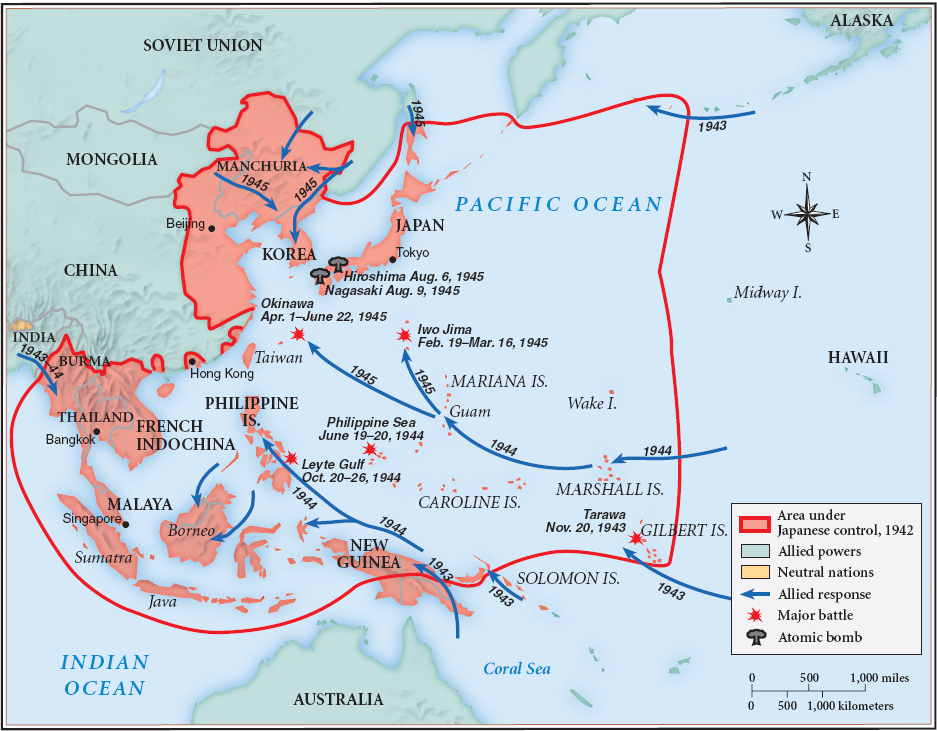America’s History: Printed Page 792
America: A Concise History: Printed Page 718
America’s History: Value Edition: Printed Page 698
The War in the Pacific
Winning the war against Japan was every bit as arduous as waging the campaign against Germany. After crippling the American battle fleet at Pearl Harbor, the Japanese quickly expanded into the South Pacific, with seaborne invasions of Hong Kong, Wake Island, and Guam. Japanese forces then advanced into Southeast Asia, conquering the Solomon Islands, Burma, and Malaya and threatening Australia and India. By May 1942, they had forced the surrender of U.S. forces in the Philippine Islands and, in the Bataan “death march,” caused the deaths of 10,000 American prisoners of war.
At that dire moment, American naval forces scored two crucial victories. These were possible because the attack on Pearl Harbor had destroyed several American battleships but left all aircraft carriers unscathed. In the Battle of the Coral Sea, off southern New Guinea in May 1942, they halted the Japanese offensive against Australia. Then, in June, at the Battle of Midway Island, the American navy severely damaged the Japanese fleet. In both battles, planes launched from American aircraft carriers provided the margin of victory. The U.S. military command, led by General Douglas MacArthur and Admiral Chester W. Nimitz, now took the offensive in the Pacific (Map 24.4). For the next eighteen months, American forces advanced slowly toward Japan, taking one island after another in the face of determined Japanese resistance. In October 1944, MacArthur and Nimitz began the reconquest of the Philippines by winning the Battle of Leyte Gulf, a massive naval encounter in which the Japanese lost practically their entire fleet (Map 24.5).


By early 1945, victory over Japan was in sight. Japanese military forces had suffered devastating losses, and American bombing of the Japanese homeland had killed 330,000 civilians and crippled the nation’s economy. The bloodletting on both sides was horrendous. On the small islands of Iwo Jima and Okinawa, tens of thousands of Japanese soldiers fought to the death, killing 13,000 U.S. Marines and wounding 46,000 more. Desperate to halt the American advance and short on ammunition, Japanese pilots flew suicidal kamikaze missions, crashing their bomb-laden planes into American ships.
Among the grim realities of war in the Pacific was the conflict’s racial overtones. The attack on Pearl Harbor reawakened the long tradition of anti-Asian sentiment in the United States. In the eyes of many Americans, the Japanese were “yellow monkeys,” an inferior race whose humanity deserved minimal respect. Racism was evident among the Japanese as well. Their brutal attacks on China (including the rape of Nanjing), their forcing of Korean “comfort women” to have sex with Japanese soldiers, and their treatment of American prisoners in the Philippines flowed from their own sense of racial superiority. Anti-Japanese attitudes in the United States would subside in the 1950s as the island nation became a trusted ally. But racism would again play a major role in the U.S. war in Vietnam in the 1960s.
As the American navy advanced on Japan in the late winter of 1945, President Roosevelt returned to the United States from the Yalta Conference, a major meeting of the Big Three at Yalta, a resort town on the Black Sea (see “Yalta” in Chapter 25). The sixty-three-year-old president was a sick man, visibly exhausted by his 14,000-mile trip and suffering from heart failure and high blood pressure. On April 12, 1945, during a short visit to his vacation home in Warm Springs, Georgia, Roosevelt suffered a cerebral hemorrhage and died.
